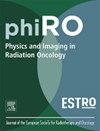孕妇乳腺癌铅笔束扫描质子放疗与光子放疗的场外剂量评估
IF 3.4
Q2 ONCOLOGY
引用次数: 0
摘要
背景和目的全世界每年每1000-2000例妊娠中就有1例患有癌症,这给平衡癌症治疗和胎儿安全带来了挑战。本研究比较了6MV外光子放疗(XRT)和铅笔束扫描质子治疗(PBS-PRT)两种治疗方式对乳腺癌的场外辐射剂量,包括成像,以评估PBS-PRT作为潜在的新治疗选择。材料与方法针对淋巴结水平1-4及乳腺内淋巴结的乳腺癌,制定XRT(带扁平滤光片(FF)和无滤光片(FFF))和PBS-PRT治疗方案,处方15 × 2.67 Gy(RBE)。测量采用拟人模型,代表怀孕20周和30周。放置在幻影腹部的气泡探测器评估PBS-PRT的中子剂量,而Farmer离子室用于成像和XRT剂量。结果在20周时,PBS-PRT包括成像的剂量为22.4 mSv,比6FFF XRT减少3.4倍,比6FFF XRT减少2.5倍。在30周时,PBS-PRT剂量为25.4 mSv,与6FF和6FFF XRT相比,分别减少了7.6倍和6.3倍。结论本研究首次比较了PBS-PRT与不同XRT方式对适应拟人化幻像的妊娠乳腺癌患者的治疗效果。PBS-PRT测量显示,即使在最坏的情况下,怀孕30周的总等效剂量也低于AAPM工作组第36号报告中概述的100毫西弗阈值,维持了治疗目标。这些发现支持采用PBS-PRT作为治疗妊娠乳腺癌患者的首选方法,如果需要放疗。本文章由计算机程序翻译,如有差异,请以英文原文为准。
Out-of-field dose assessment for pencil beam scanning proton radiotherapy versus photon radiotherapy for breast cancer in pregnant women
Background and purpose
Cancer affects 1 in 1000–2000 pregnancies annually worldwide, creating challenges in balancing cancer treatment and fetal safety. This study compares out-of-field radiation doses between two treatment modalities: 6MV external photon radiotherapy (XRT) and pencil beam scanning proton-therapy (PBS-PRT) for breast cancer, including imaging, to evaluate PBS-PRT as a potential new treatment option.
Materials and methods
For breast cancer involving lymph node levels 1–4 and the intramammary lymph nodes, treatment plans were created for XRT (with Flattening Filter (FF) and FF-Free (FFF)) and PBS-PRT, prescribing 15 × 2.67 Gy(RBE). Measurements were conducted using an adapted anthropomorphic phantom representing 20- and 30-week pregnancy. Bubble detectors placed in the phantom’s abdomen assessed neutron dose from PBS-PRT, while a Farmer ion chamber was used for imaging and XRT dose.
Results
At 20 weeks, PBS-PRT including imaging delivered 22.4 mSv, reducing dose 3.4-fold versus 6FF XRT and 2.5-fold versus 6FFF XRT. At 30 weeks, the PBS-PRT dose was 25.4 mSv, resulting in 7.6-fold and 6.3-fold reductions compared to 6FF and 6FFF XRT, respectively.
Conclusions
This study presents the first one-by-one comparison between PBS-PRT and different XRT modalities for pregnant breast cancer patients with an adapted anthropomorphic phantom. PBS-PRT measurements showed that the total equivalent dose was below the 100 mSv threshold outlined in AAPM Task Group Report No. 36 for a 30-week pregnancy, even under a worst-case scenario, maintaining treatment goals. These findings support the adoption of PBS-PRT as the preferred approach for treating pregnant breast cancer patients, should radiotherapy be required.
求助全文
通过发布文献求助,成功后即可免费获取论文全文。
去求助
来源期刊

Physics and Imaging in Radiation Oncology
Physics and Astronomy-Radiation
CiteScore
5.30
自引率
18.90%
发文量
93
审稿时长
6 weeks
 求助内容:
求助内容: 应助结果提醒方式:
应助结果提醒方式:


